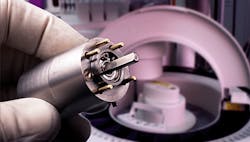Richard Halsted is president of Empire Magnetics.
What have been the biggest improvements to motor and drives in the past five years?
Richard Halsted, president, Empire Magnetics: Primary improvements have been in the computer programs to model magnetics and thermal behavior of motors, allowing significant efficiency improvements prior to expending resources on prototypes.
What’s the most innovative or efficient motor/drive application you’ve ever seen or been involved with?
Richard Halsted, president, Empire Magnetics: NASA is working to revive liquid-fueled rockets for missions to Mars. The idea is to make liquid oxygen and liquid methane on Mars to use as fuel for the return to Earth. High-reliability motors are needed to control the fuel valves. These mission-critical motors must also tolerate launch vibrations, function in extreme cold, operate in a vacuum and meet precise weight requirements—not your everyday problem.
How have motors and drives benefitted from remote monitoring and connectivity?
Richard Halsted, president, Empire Magnetics: For typical industrial applications, vibration monitors provide predictions of bearing failures so that they can be replaced at convenient times.
Also read: Ease of use dominates motor and drive trends
Can you explain how software development has changed motor and drive design and production?
Richard Halsted, president, Empire Magnetics: With more powerful computers and advanced software, magnetic modeling has become more precise. This has significantly improved the design process, so it becomes feasible to go from design to production without multiple iterations.
How do motors and drives figure into digital-twin platform models being used by manufacturers?
Richard Halsted, president, Empire Magnetics: We see digital twins being used at the system level, where motors and drives are integrated into larger production facilities. I have not seen this being used for the manufacture of electric motors themselves.
When will motors and drives become IT-friendly enough that engineers are no longer required for installation and operation?
Richard Halsted, president, Empire Magnetics: I don’t see this happening in the near future. While the installation and setup of a system selected by an engineer has become easier, the background necessary to appropriately select the technology, size the motors and all the associated items such as gearing, feedback, limit switches and proximity sensors are likely to remain a specialty for the foreseeable future.
What future innovations will impact the use of motors and drives in discrete-manufacturing operations?
Richard Halsted, president, Empire Magnetics: In the near term, additive manufacturing is likely to replace castings and other metal components in the production of short-run motors. Laser cutting of laminations is also going to impact the business of customized motor products.
That said, due to the toxic materials used in the insulation systems and the lack of suitable alternatives, plus metal plating, painting and other treatments that require special handling. Custom motors are likely to remain a business that requires significant capital investments in order to manufacture the end products.
Tell us about your company’s state-of-the-art motor.
Richard Halsted, president, Empire Magnetics: For a number of years, our customer has been trying to use modified versions of ac motors to operate fans in cryochambers. Some units last a week, while others might endure as long as six months. With unmet challenges and the increasing costs to service these chambers, this customer contacted Empire Magnetics to tackle this project. We just delivered the first of 250 units for the customer to test. The three-phase, 220 Vac, ¼-hp motor is designed to operate from -125 °C to +80 °C (Figure 1).
Mike Bacidore is the editor in chief for Control Design magazine. He is an award-winning columnist, earning a Gold Regional Award and a Silver National Award from the American Society of Business Publication Editors. Email him at [email protected].
About the Author
Mike Bacidore
Editor in Chief
Mike Bacidore is chief editor of Control Design and has been an integral part of the Endeavor Business Media editorial team since 2007. Previously, he was editorial director at Hughes Communications and a portfolio manager of the human resources and labor law areas at Wolters Kluwer. Bacidore holds a BA from the University of Illinois and an MBA from Lake Forest Graduate School of Management. He is an award-winning columnist, earning multiple regional and national awards from the American Society of Business Publication Editors. He may be reached at [email protected]

Leaders relevant to this article:


